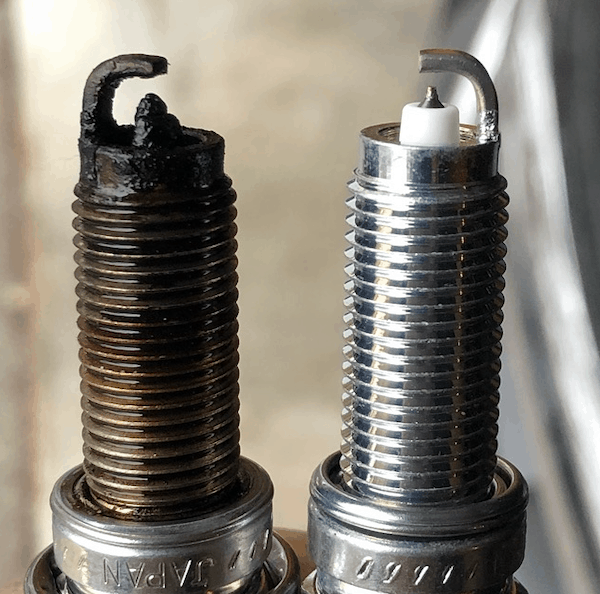
Identifying Bad Spark Plugs
When inspecting your vehicle’s spark plugs, you may notice several indicators that suggest a replacement is needed.
Keep an eye out for the following signs:
- Physical Damage: Cracks or chips on the spark plug insulator can cause misfires and poor engine performance.
- Wear and Tear: Over time, the electrode wears down, resulting in a wider gap that impacts the spark quality.
- Corrosion: Look for rust or corrosion on the plug’s metal parts, as it can hinder electrical conductivity.
- Carbon Deposits: A sooty, black coating indicates a rich fuel mixture or poor combustion, leading to fouling.
- Oil Contamination: Oil on the spark plug points to issues like worn piston rings or valve guides leaking oil into the combustion chamber.
Below is a table highlighting common symptoms and their possible implications:
| Symptom | Possible Implication |
|---|---|
| Misfiring | Inconsistent sparking |
| Rough idling | Irregular power delivery |
| Difficulty in starting | Spark plug not igniting fuel properly |
| Poor acceleration | Reduced engine performance |
Physical Symptoms of Bad Spark Plugs

When your spark plugs begin to fail, their physical appearance changes. These changes can affect your vehicle’s performance.
It’s important to check your spark plugs regularly to spot these signs of deterioration.
Erosion and Wear
- Electrode Erosion: You may notice the electrodes on your spark plugs are rounded and have lost their sharp edges. This is often due to normal wear but can be accelerated by engine misfiring.
- Reduced Electrode Size: Prolonged usage thins and shortens the center and ground electrodes, which can lead to misfires and poor ignition.
Oil or Carbon Deposits
- Black, Sooty Deposits: These can indicate a rich fuel mixture or oil leaking into the combustion chamber.
- Dry, Dusty Carbon Build-up: If your plugs are coated with a matte black powder, it could be a sign of a weak spark or poor fuel economy.
Broken Insulator
- Physical Damage: Look for any cracked or chipped insulators, as they can lead to misfiring and decreased engine performance.
- Discoloration: Any white or tan colored insulator may suggest a pre-ignition condition or overheating.
Engine Performance Issues
When your vehicle has faulty spark plugs, you might experience several engine performance issues. These problems can range from minor annoyances to more significant concerns that can affect your vehicle’s operation.
Look out for the following signs:
- Misfires: You may notice your engine suddenly cuts out for a brief moment and then continues running. This is often referred to as a misfire and can occur when a spark plug fails to ignite the fuel-air mixture properly.
- Rough Idling: A rough or bouncy sensation might be felt when your car is running but not moving. It indicates that the engine isn’t running as smoothly as it should, possibly due to worn spark plugs.
- Acceleration Problems: If your car hesitates or ‘jerks’ when you accelerate, it could be a sign that your spark plugs need attention.
- Increased Fuel Consumption: Bad spark plugs can reduce fuel efficiency. If you find yourself filling up the tank more often than usual, it’s worth checking your spark plugs.
- Engine Light: Your ‘Check Engine’ light may come on. While this light can indicate a variety of issues, it’s a good first clue that you should inspect your spark plugs among other engine components.
- Startup Troubles: If your car struggles to start or there is a delay, this can sometimes be traced back to faulty spark plugs.
Starting Problems in the Vehicle
When your vehicle has trouble starting, it may be related to the condition of the spark plugs.
Bad spark plugs can cause various starting issues:
- Slow Cranking: The engine turns over sluggishly if your spark plugs aren’t functioning properly.
- Misfires: You might notice the engine misfires during startup, which can lead to inconsistent and rough idling.
- Inconsistency: The car may start sometimes and fail to start at other times.
Identifying a bad spark plug:
- Visual Inspection: Look for signs of wear or damage on the spark plug’s electrodes.
- Excessive soot
- Erosion
- Oil deposits
- Engine Codes: Modern vehicles will trigger engine codes that can help pinpoint a spark plug issue. Use an OBD II scanner to check for codes.
- Professional Diagnosis: If you’re unsure, a mechanic can perform a comprehensive check to confirm if the spark plugs are the culprit.
Maintenance Tips:
- Check your owner’s manual for the recommended spark plug replacement interval.
- Ensure good quality spark plugs are installed to promote efficient engine performance.
Fuel Efficiency and Emissions
When your spark plugs are failing, fuel efficiency often drops. This happens because your engine struggles to burn fuel properly.
As a result, you might notice:
- Wasted fuel
- Increased emissions
- Higher costs at the gas station
A bad spark plug might cause a misfire. If your vehicle is misfiring, you might notice:
- Your engine stutters during acceleration.
- You’re visiting the gas station more often.
The appearance of your spark plug can indicate problems:
- A sooty spark plug points to a rich fuel mixture.
- An oily plug could mean oil leakage into the combustion chamber.
In terms of emissions, poor spark plug health directly impacts:
- The release of unburned hydrocarbons.
- The effectiveness of your catalytic converter.
Key check points for emissions include:
- Overly dark exhaust.
- A rotten egg smell from excess sulfur compounds.
Regularity in spark plug checks prevents these problems. By maintaining your spark plugs, you:
- Optimize fuel use.
- Reduce harmful emissions.
